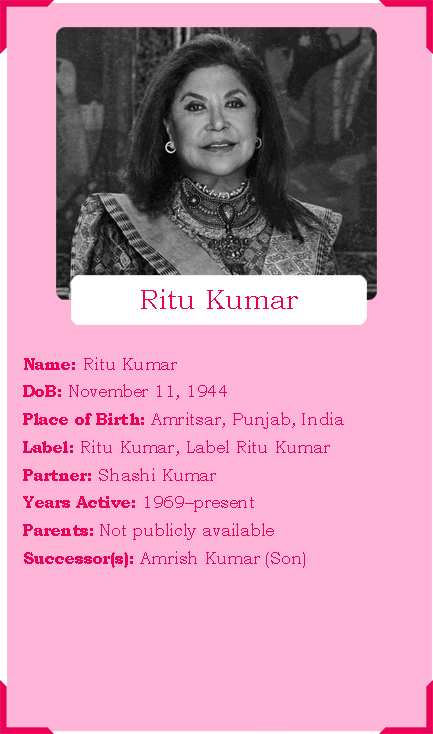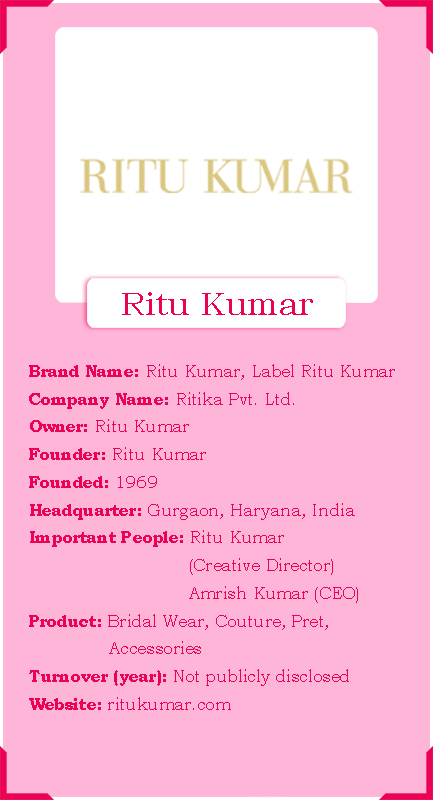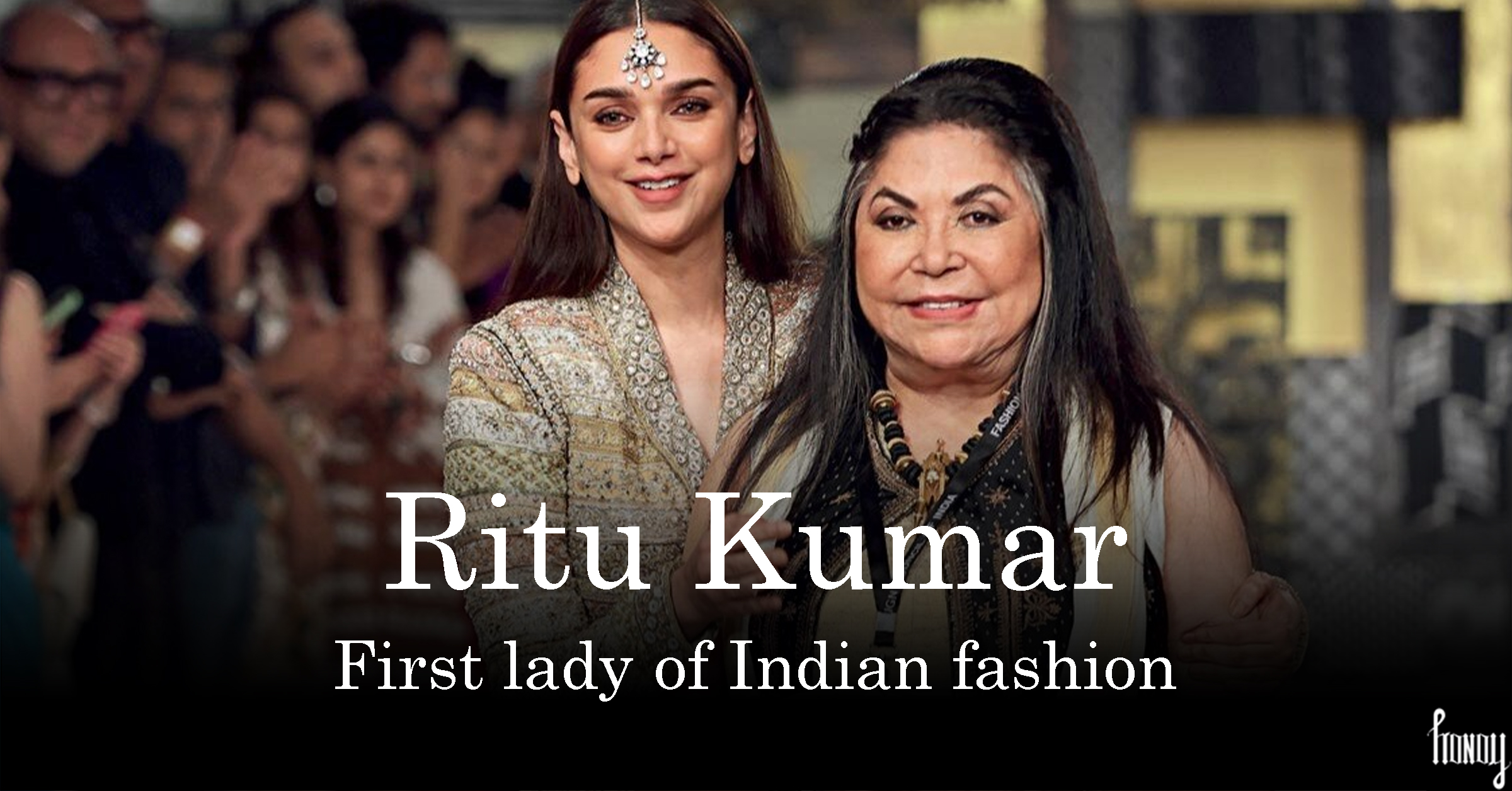Introduction to Ritu Kumar

Ritu Kumar, a pioneer of Indian fashion, is often referred to as the “The first lady of Indian Fashion.” Since starting her career in the late 1960s, Kumar has transformed the Indian fashion industry by combining traditional craftsmanship with contemporary design. Her work has left an indelible mark not just on Indian fashion, but globally as well. Kumar’s designs celebrate India’s rich textile heritage, and her efforts in promoting traditional Indian arts and crafts have earned her a special place in the fashion world. She once said, “India lives in its villages,” which is reflected in her use of indigenous techniques and fabrics. Kumar’s commitment to sustainability, heritage, and culture makes her a standout figure in fashion.
Early Life and Background
Born on November 11, 1944, in Amritsar, Punjab, Ritu Kumar grew up during a period of change in post-independence India. Her early exposure to India’s vibrant culture and traditions shaped her worldview, which is reflected in her work today. Kumar’s love for textiles and design was influenced by her visits to local artisans and weavers in Indian villages, where she witnessed age-old weaving and dyeing techniques firsthand.
Ritu pursued her education at Lady Irwin College, Delhi University, where she earned a degree in History. She further honed her skills in art history at Briarcliff College, New York. During her stay in the U.S., Kumar was exposed to global art movements and modern design principles, but her heart was always drawn back to Indian textiles and traditions.
Career Beginnings
Ritu Kumar’s fashion journey began in 1969 when she opened a small boutique in Kolkata with just four hand-block printers and two tables. Her initial focus was on bridal wear and evening dresses that combined traditional Indian techniques with contemporary silhouettes. Unlike most designers of her time, Kumar was deeply involved in the production process, working closely with artisans to revive traditional crafts such as hand-block printing, embroidery, and weaving.
Her early collections were simple yet elegant, featuring handwoven saris and blouses that embraced the intricacies of Indian textiles. Despite the limited resources, Kumar’s designs soon caught the attention of fashion enthusiasts. However, it wasn’t an easy ride. The fashion industry in India was still in its infancy, and there was little understanding or appreciation for couture or designer wear.
Rise to Fame

Kumar’s breakthrough came in the 1970s when her work was featured in major Indian fashion shows. Her 1976 collection, which featured traditional Indian textiles like khadi, brocade, and silk, gained widespread attention. She was lauded for her efforts in reviving ancient textile techniques and giving them a modern twist. This collection was a turning point in her career, as it established her as a leading figure in Indian fashion.
In the 1980s, Kumar’s popularity soared as she expanded her brand both in India and internationally. Her designs were worn by Indian celebrities, and her bridal collections became highly sought after. In 1994, she dressed India’s Miss Universe Sushmita Sen and Miss World Aishwarya Rai, further solidifying her global recognition.
Signature Style and Innovations
Ritu Kumar is celebrated for her use of traditional Indian textiles and techniques, which form the backbone of her signature style. Her designs often feature hand-block prints, intricate embroidery, and rich fabrics like silk, cotton, and brocade. Kumar’s collections pay homage to India’s diverse cultural heritage, drawing inspiration from regions like Rajasthan, Bengal, and Kashmir.
What sets Kumar apart is her ability to blend the old with the new. While her designs are rooted in tradition, they also cater to modern sensibilities. She was among the first Indian designers to introduce India to the concept of “pret” or ready-to-wear fashion, and her bridal collections are known for their timeless appeal.
Kumar’s 2002 collection, which focused on the art of hand embroidery, became iconic. It showcased the skills of Indian artisans, featuring complex zardozi and gota work. Her “Label Ritu Kumar” line, launched in 2002, brought a younger and more contemporary take to her brand, appealing to the fashion-forward generation.
Impact on the Fashion Industry
Ritu Kumar’s influence on the Indian fashion industry cannot be overstated. She played a crucial role in creating awareness about India’s rich textile traditions both at home and abroad. Her work has helped preserve dying crafts, as she has continuously employed artisans from small Indian villages to create her collections.
Kumar was instrumental in organizing India’s first-ever fashion week, Lakmé Fashion Week, in 2000. She continues to be a strong advocate for promoting sustainable fashion and traditional craftsmanship. Her contribution to the preservation of Indian textile art earned her the Padma Shri award in 2013, one of India’s highest civilian honors.
Notable Collaborations and Projects
Over the years, Kumar has collaborated with numerous celebrities, designers, and brands. One of her most notable collaborations was with Bollywood, where she designed costumes for several films, including “The Guru” (2002), which brought her international recognition.
In 2015, Kumar collaborated with Kiehl’s, a luxury skincare brand, to raise funds for education. The project combined her signature design aesthetics with philanthropy, helping to support underprivileged children.
Kumar has also been involved in costume design for cultural events and plays. Her creations were used in performances that aimed to showcase India’s heritage to the world.
Personal Life and Public Persona
Ritu Kumar’s private life has largely been kept out of the public eye. She is married to Shashi Kumar, and they have a son, Amrish Kumar, who is actively involved in the business. Amrish is currently the CEO of Ritu Kumar’s fashion house and has played a key role in modernizing the brand while keeping its core values intact.
Kumar is known for her grace, humility, and passion for Indian culture. She remains a mentor to young designers and continues to inspire through her work. Media coverage of Kumar often highlights her dedication to reviving and sustaining Indian arts and crafts.
Legacy and Continuing Influence
Ritu Kumar’s impact on fashion is enduring. She has not only shaped Indian couture but has also influenced designers around the world. Her dedication to traditional Indian crafts has created a pathway for future generations of designers who seek to blend heritage with modernity.
Kumar’s brand has grown into a global fashion powerhouse, with stores across India and abroad. Under the leadership of Amrish Kumar, the brand has expanded its digital presence and introduced eco-friendly fashion lines, ensuring that Ritu Kumar’s legacy continues in the modern world.
Conclusion
With over five decades in the fashion industry, Ritu Kumar remains a true icon of Indian fashion. Her ability to blend tradition with modernity has set her apart, and her work has helped shape the future of Indian fashion. Kumar’s contributions go beyond clothing; she has created a movement that celebrates Indian heritage, empowers artisans, and champions sustainability. As we look ahead, Kumar’s influence will continue to inspire new generations of designers, ensuring that her legacy remains timeless.
For those eager to explore her work, Ritu Kumar’s collections offer a window into India’s rich textile traditions, reimagined for today’s world. Visit ritukumar.com to dive into her timeless creations. Do let me know if this was sufficient information on the first lady of Indian fashion or is there anything that I have missed.





























Pingback: fascinating metal craft of Chattisgarh: Dhokra 5 min
Pingback: International Vs. Indian Fashion Industry In 5 Easy Points